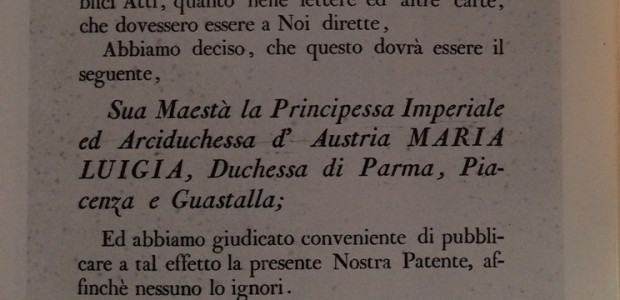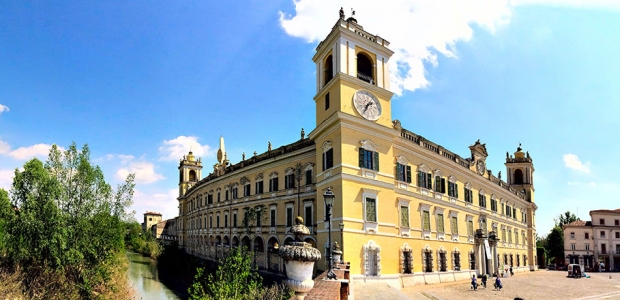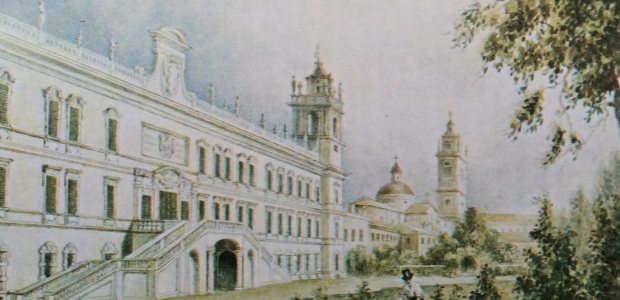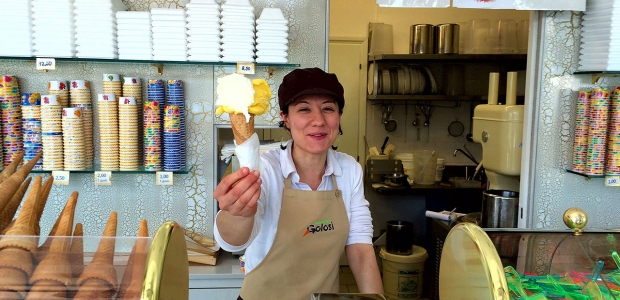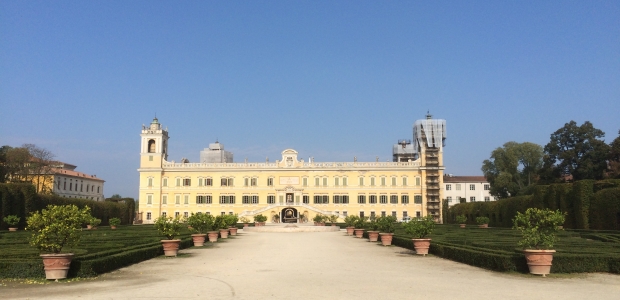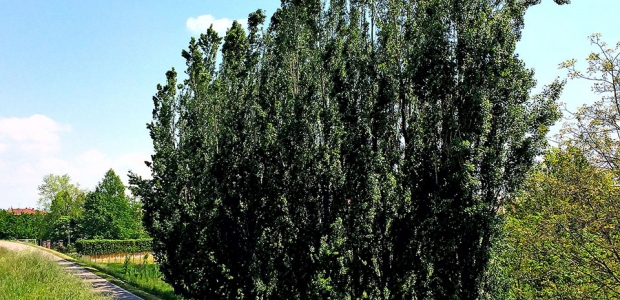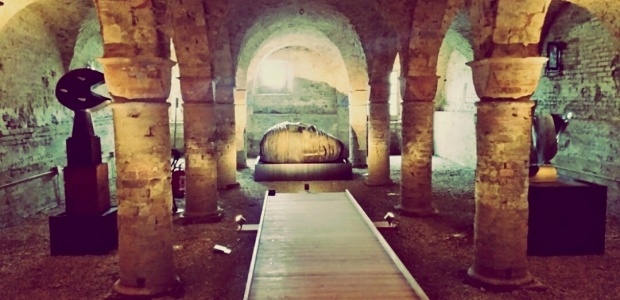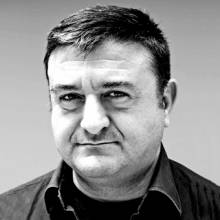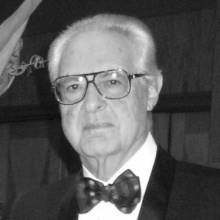Languages
The Duchess meets her Reign
From Colorno to Parma: Maria Luigia is enthroned in Parma, Piacenza and Guastalla.
The secondary roads of the Bassa parmense (an area of Plain of the River Po, in the north of Parma, between The Big River and Via Emilia, among River Enza and Creek Ongina) from Colorno to Parma, mostly in Spring and Summer, offer the opportunity for itineraries with no hurry, that find in search of the details their reason for existence.
The April 19, 1816 Her Majesty the Princess Imperial and Archduchess Marie Louise of Austria, Duchess of Parma, Piacenza and Guastalla enters the territory of the Duchy. A few months ago it was granted in life annuity by the Congress of Vienna, after the final defeat of her husband, Napoleon, that she had decided not to go into exile in the remote St. Helena Island.
It was a morning of unstable weather, but when she arrived, "here the clouds disappear gradually without sigh/whoosh of the wind, laugh the beautiful clear sky, so also the Nature welcomes August Traveller in her Dukedom." So wrote the chronicler of the "Gazzetta di Parma" the April 23, 1816.
It’s easy to imagine her slow journey along the Po, from Guastalla to Colorno, through poplars and flowering season. The surviving presence of Violets in the most shadowy places, reminds us the favorite flower of the Duchess, that every year a group of Parmesans, on pilgrimage on her tomb in the Crypt of the Capuchins in Vienna, depose as tribute.
Vienna was the city of childhood of Marie-Louise von Österreich, who decided with a decree 29 February 1816 to Italianize her name in Maria Luigia before to leave for Emilia.
She crossed the Great River Po in Casalmaggiore, walking along a pontoon bridge long 363 meters,
built for the occasion by Antonio Cocconcelli, at the end of which the Town of Parma had raise/erect two great pyramids. Just came back on dry land, she boarded the carriage towards Colorno.
Along the way, following the bank of Parma, one meets with the Oratory of Copermio with sloping and colorful roof, it recall surprisingly the coverage in polychrome majolica of St. Stephen's Cathedral in Vienna. It’s nice to think that the future Duchess of Parma has glimpsed it in the distance while she entered in Colorno for to stay in the Royal Palace, on April 18 at seven in the evening, which was to become her favorite summer residence.
The Colorno’s Palace, with its more than 400 rooms, halls and courtyards, that now home among others Alma, the International School of Italian Cuisine, and its garden, carried back to the eighteenth-century structure of French Garden in 2000, probably they remembered her the life as Empress in Paris.
The Royal Palace was commission by Ranuccio Farnese in 1660 on the Fortress of Azzo from Correggio. The different architectural restyles have the signature of French architects, among them Ennemond Alexandre Petitot, who designed the monumental staircase and rearranged the garden.
Another story connects Colorno, Maria Luigia, Paris, ruling families and violets in an unexpected way: the ice cream. The visitor perhaps attracted by the exhibition "The sign of the lily" “Il segno del giglio”, which for three days in late April fills the gardens of the Palace of flowers and ornamental plants, seeking relief from the first warm afternoons, he will find not far the ice-cream shop "Naturalmente Golosi."
Every year the master of ice-cream invent new innovative tastes, just in spring, which will dominate the hot summer in Colorno and that in some cases owe their existence to the Duchess. An example is the ice cream taste Parma Violet. This taste is reminiscent of the alert tourist, the Duchess’s predilection for Violet suavis, by herself cultivated. This unique connection could also recall to mind of other travelers the story of the nobleman Francesco Procopio dei Coltelli, who came to Paris from Palermo in 1660. He built his famous café, "Le Procope" in 1686 on Rue des Fosses Saint Germain, today Rue de l'Ancienne Comedie, and he became an ice cream man so famous, that he was received at the Tuileries Palace by King Louis XIV.
But let us get back to the journey of Maria Luigia, who came out of the palace the next day, 20 April 1816, and boarded the ducal berlin, followed by another 18 carriages towards Parma. We imagine her while on the Asolana road looks out the window and sees a campaign, now, remained essentially unchanged after two centuries. At the first layers of the city, the Duchess had to admire the impressive architecture of the Certosa di Paradigna, which now houses the Centre for Communication Studies and Archives (CSAC) and its important collection of works of art, which since 23 May 2015 became museum public and not just for students. Not far away, the waters of irrigation canals and their vegetation draw other routes just as fascinating.
The official entry in the duchy happened at three in the afternoon through San Michele Gate and shortly after Maria Luigia of Austria wrote to his father:
The people welcomed me with such enthusiasm that I had tears in his eyes.
A fitting end for a city that still believes the wise Archduchess one of the emblems of Parma, a sort of sacred figure and protector, and that on the musical melodrama has built its reputation and which has its “sacred place” in the Royal Theatre (Teatro Regio), wanted by the Duchess.
The traveler, who arrived in Parma, after visiting the Glauco Lombardi Museum, where are collected all the furnishings of Maria Luigia, jewelry and personal items, and walked the trails of the beautiful Garden of the Ducal Palace, a rare example of a princely park, which the Sovereign of Parma wanted to be open for all the citizens, he may decide that it's time to stay in town and play on his gluttony. It can be overwhelmed by cold cuts,Parmesan shavings, tortelli, breast of beef roasted in the oven ... dishes worthy of an Empress, or rather a "Good Duchess". This is not only the memory of Parma felix that was, but also gastronomic gift, a kind of roll or "pocket" of meat, stuffed with Ham and Parmesan, that many restaurants in Parma and province continue to have on the menu, or in the shape of cake hypercaloric and for true connoisseurs/expert.
